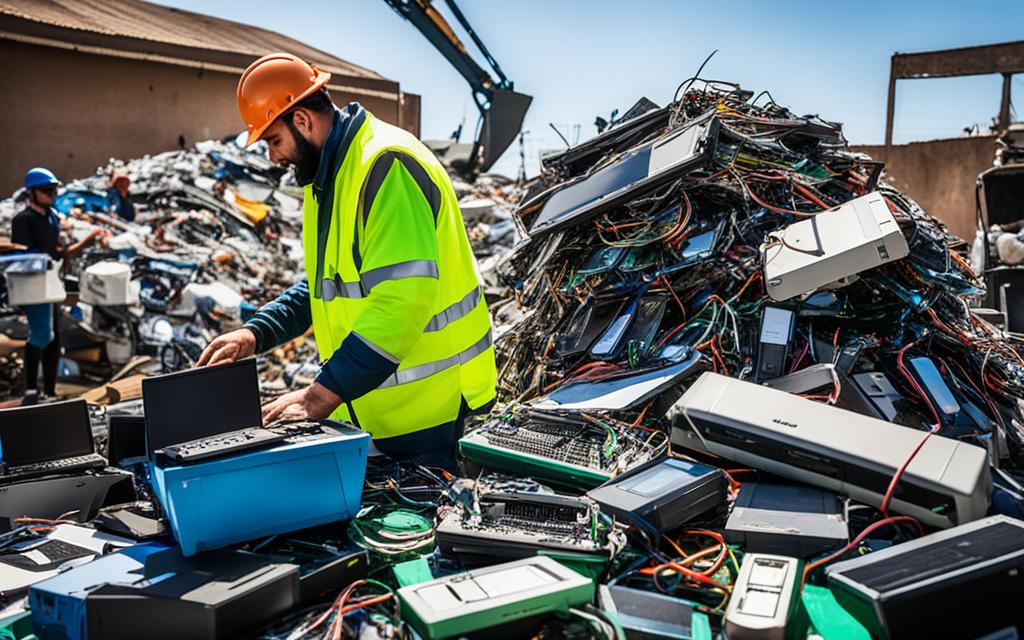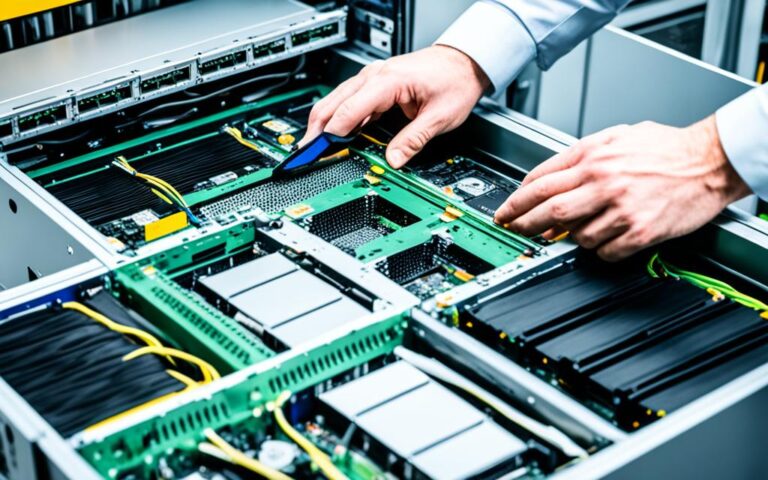Server Recycling: Addressing the Digital Divide
In today’s digital age, access to technology and the internet is crucial for economic, educational, and social opportunities. However, not everyone has equal access, creating a digital divide. Simultaneously, the growth of electronic waste poses environmental risks. IT recycling plays a vital role in bridging the digital divide by refurbishing and recycling donated technologies. It promotes digital inclusion and equal opportunities while preventing e-waste from harming the environment.
Understanding the Digital Divide
The digital divide is a term used to describe the disparities in technology access and internet usage that exist in society. In the United Kingdom, approximately 10% of adults do not use the internet, highlighting the extent of this divide.
Several factors contribute to the digital divide, including socio-economic status, education level, and geographical location. Individuals from lower socio-economic backgrounds may face greater barriers to accessing technology, such as the cost of devices and internet services. Additionally, those with lower levels of education may lack the necessary skills and knowledge to effectively utilize digital technologies.
Geographical location also plays a significant role in the digital divide. Rural areas and remote communities may have limited infrastructure and connectivity options, making it challenging for residents to access the internet and engage with online resources.
The consequences of the digital divide are far-reaching. Limited access to technology hinders education and learning opportunities, as digital resources and online courses become increasingly prevalent. Job prospects may be limited for individuals without digital skills, as many industries now require technology proficiency. Furthermore, the digital divide can isolate individuals from social connectivity, as online platforms become essential for communication, community engagement, and accessing vital services.
Addressing the digital divide is essential for creating an inclusive society with equal opportunities for all. It requires efforts to promote technology access, improve digital literacy, and enhance connectivity infrastructure. Governments, organizations, and communities must work together to bridge this divide and ensure that everyone has the opportunity to benefit from the advantages of the digital era.
Impact of E-Waste on the Environment
E-waste, including computers, cell phones, and printers, is one of the fastest-growing waste streams globally. As technology advances and consumer demand increases, the volume of electronic waste continues to rise at an alarming rate. When not properly managed, e-waste can have significant environmental and health implications.
E-waste contains toxic substances such as lead, mercury, and arsenic, which are harmful to both ecosystems and human health. When disposed of improperly, these toxic materials can leach into the soil, water, and air, contaminating the environment and posing risks to wildlife and communities.
Proper electronic waste recycling is crucial for sustainable waste management and preventing environmental hazards. By recycling e-waste, we can recover valuable materials and reduce the need for new resource extraction.
Electronic waste recycling involves the responsible dismantling, sorting, and processing of end-of-life electronic devices to extract usable components and materials. This process helps conserve natural resources, reduce energy consumption, and minimize greenhouse gas emissions associated with the production of new electronics. Furthermore, recycling e-waste prevents toxic substances from polluting the environment and enables the reuse of valuable materials in the manufacturing of new products.
Environmental Impact of E-Waste:
- E-waste contributes to soil contamination, affecting agricultural productivity and the health of ecosystems.
- Improper disposal of e-waste pollutes water sources, impairing water quality and endangering aquatic life.
- The incineration of e-waste releases toxic substances into the air, leading to air pollution and respiratory illnesses.
- Electronic waste contains valuable materials like gold, silver, and copper. Recycling these materials reduces the need for resource extraction, conserving natural resources and reducing energy consumption.
By recycling e-waste, we can mitigate the environmental impact of electronic waste and create a more sustainable future. Through responsible disposal and recycling practices, we can protect the environment, conserve valuable resources, and minimize the health risks associated with e-waste.
The Role of IT Recycling in Bridging the Digital Divide
IT recycling plays a crucial role in bridging the digital divide and promoting digital inclusion for everyone. By refurbishing and recycling donated devices, organizations make affordable technology accessible to individuals and communities who may otherwise not have access. This helps create equal opportunities and empower individuals in various aspects of life, including education, employment, and social connectivity.
Through IT recycling, donated devices are refurbished to ensure they are in good working condition. These devices are then made available at lower prices, making them affordable for individuals and organizations with limited financial resources. By providing access to refurbished technology, IT recycling addresses the digital divide and ensures that more people can benefit from the opportunities that come with being connected in today’s digital world.
One key benefit of IT recycling is its contribution to environmental sustainability. By recycling and reusing technology, electronic waste is reduced, minimizing the release of toxic substances into the environment. As electronic waste, such as computers and cell phones, poses significant environmental risks, IT recycling plays a vital role in preventing further pollution and protecting our planet.
“IT recycling not only helps bridge the digital divide, but it also makes a positive impact on reducing electronic waste and promoting sustainability.”
By choosing to recycle and reuse technology, we actively contribute to a more sustainable future. IT recycling is an essential part of a circular economy, where resources are used efficiently, reducing the demand for new electronic devices and minimizing the environmental impact of manufacturing processes. It enables us to make a positive social impact while addressing the global challenge of electronic waste.
Furthermore, IT recycling creates a ripple effect of social benefits. When individuals and communities gain access to affordable technology through IT recycling, they are empowered to improve their lives and participate more actively in society. This includes access to quality education, job opportunities, healthcare services, and essential information. By bridging the digital divide, IT recycling helps foster a more inclusive society where everyone has equal opportunities to thrive and succeed.
In summary, IT recycling plays an instrumental role in bridging the digital divide by providing access to affordable technology, reducing electronic waste, and creating positive social impact. By choosing to recycle and reuse technology, we contribute to a more sustainable future and help create a society where equal opportunities are accessible to all.
| Benefits of IT Recycling in Bridging the Digital Divide |
|---|
| Provides access to affordable technology |
| Promotes digital inclusion and equal opportunities |
| Reduces electronic waste and environmental pollution |
| Empowers individuals and communities |
Benefits of IT Recycling in Bridging the Digital Divide
IT recycling offers several benefits in bridging the digital divide. By facilitating access to affordable technology, IT recycling plays a vital role in promoting digital inclusion and equal opportunities for all members of society.
Through the refurbishment and recycling of donated devices, IT recycling makes affordable technology accessible to individuals and communities who may otherwise struggle to afford new devices. This affordability enables improved access to education, job opportunities, and essential services, helping to bridge the digital divide and empower individuals to thrive in the digital age.
Not only does IT recycling enhance access to affordable technology, but it also contributes to environmental sustainability. By diverting electronic waste from landfills, IT recycling prevents the release of toxic substances into the environment, safeguarding our planet and ensuring a healthier future for all. By participating in IT recycling, we become responsible stewards of the environment while promoting equity in access to technology.
Furthermore, IT recycling fosters a more circular economy by reducing the consumption of raw materials needed for manufacturing new devices. The recycling and reusing of technology through IT recycling initiatives conserve resources and energy. This, in turn, helps to mitigate the environmental impact associated with the production and disposal of electronic devices, making IT recycling an important component of sustainable consumption practices.
In summary, the benefits of IT recycling in bridging the digital divide are manifold. It increases access to affordable technology, enabling digital inclusion and equal opportunities for all. Simultaneously, IT recycling promotes environmental sustainability by reducing electronic waste and conserving valuable resources. By embracing IT recycling, we can create a more equitable and environmentally friendly society.
Circular Electronics for Social Good
Circular electronics is a transformative model that embraces the principles of reusing and repairing used electronics to provide affordable technology access to underserved communities. This innovative approach not only bridges the digital divide but also brings about a positive social impact and promotes sustainable consumption.
By repurposing and refurbishing IT equipment, circular electronics significantly reduces electronic waste and the environmental footprint associated with its disposal. This sustainable practice helps conserve valuable resources and prevents harmful substances from polluting our planet.
Moreover, circular electronics plays a vital role in increasing digital inclusion. By making affordable technology available to underserved communities, this model breaks down barriers to access and empowers individuals with equal opportunities. It enables people to connect, learn, and take advantage of the numerous benefits that the digital world has to offer.
Businesses are increasingly recognizing the immense potential of circular electronics to drive both social and environmental change. Through conscious efforts to reuse their IT equipment, they contribute towards building a more sustainable and equitable future. These initiatives not only foster positive social impact but also demonstrate a commitment to corporate social responsibility.
The image above illustrates the transformative power of circular electronics in fostering social good and sustainable consumption. It serves as a visual reminder of the positive impact that businesses and individuals can create by embracing circular practices and prioritizing the needs of underserved communities.
Challenges and Future Directions of Corporate IT Recycling
Corporate IT recycling is not without its challenges. From the collection of equipment to the sorting and dismantling process, there are several obstacles that need to be overcome. One of the major concerns is data security. With the increasing amount of sensitive information stored on electronic devices, ensuring data privacy during the recycling process is crucial.
Another challenge faced by corporate IT recycling is the cost associated with recycling. Properly disposing of electronic waste can be expensive, especially when considering the specialized equipment and processes required. Additionally, the lack of demand for recycled materials poses a challenge, making it difficult to find sustainable solutions for the disposal of electronic waste.
Despite these challenges, the future of IT recycling holds promising opportunities. Emerging technologies such as artificial intelligence, blockchain, and the Internet of Things offer innovative and cost-efficient recycling practices. These technologies have the potential to streamline the recycling process, reduce costs, and improve the overall efficiency of IT recycling operations.
Furthermore, future developments in regulatory compliance and changes in consumer behaviors will shape the direction of IT recycling. As governments implement stricter regulations on electronic waste disposal and consumers become more conscious of their environmental impact, the demand for responsible IT recycling practices will continue to grow.
Responsible corporate IT recycling is crucial for sustainability and a greener future. By overcoming the challenges and embracing emerging technologies, businesses can contribute to reducing electronic waste, conserving resources, and creating a more environmentally friendly society.
The Future of IT Recycling
In the future, IT recycling will play an even larger role in addressing the challenges of electronic waste and bridging the digital divide. The rapid advancements in technology will lead to an increase in the volume of electronic devices that require recycling. With this growth, it is essential to develop efficient and sustainable IT recycling practices.
The future of IT recycling lies in the adoption of circular economy principles. By transitioning from a linear model of production and disposal to a circular model of reuse and recycling, IT recycling can become a more sustainable and cost-effective process.
Additionally, the development of innovative technologies will revolutionize the recycling industry. For example, advancements in robotics and automation can enhance the efficiency of sorting and dismantling processes, improving the recovery of valuable materials. Furthermore, the integration of blockchain technology can provide transparency and traceability to the recycling chain, ensuring the responsible disposal of electronic waste.
In conclusion, the challenges faced by corporate IT recycling are significant, but the future is bright. By embracing emerging technologies, such as AI, blockchain, and the IoT, and adopting circular economy principles, the IT recycling industry can overcome these challenges and contribute to a more sustainable and inclusive society.
| Challenges of Corporate IT Recycling | Future Directions of IT Recycling |
|---|---|
| Data security concerns | Adoption of blockchain technology for secure and transparent recycling |
| High recycling costs | Advancements in robotics and automation for more cost-efficient recycling processes |
| Lack of demand for recycled materials | Transition to a circular economy model for increased demand and resource conservation |
| Integration of AI for improved sorting and dismantling processes |
By addressing these challenges and embracing future directions, corporate IT recycling can lead the way towards a sustainable future, where electronic waste is properly managed and the digital divide is bridged.
Conclusion
IT recycling is a critical solution for addressing the digital divide and promoting digital inclusion. Through the provision of affordable technology, IT recycling creates equal opportunities for all individuals, regardless of their socio-economic background. By refurbishing and recycling donated devices, IT recycling reduces the financial barriers that hinder access to technology, allowing individuals to participate fully in the digital world.
Furthermore, IT recycling contributes to environmental sustainability by effectively managing e-waste. By recovering valuable materials from discarded devices and preventing toxic substances from polluting the environment, IT recycling minimizes the environmental impact of electronic waste. This responsible approach to waste management aligns with the principles of a greener future and promotes the long-term well-being of our planet.
With the continued efforts and advancements in technology, corporate IT recycling has the potential to make a significant contribution to building a more sustainable and inclusive society. By embracing emerging technologies and implementing cost-efficient recycling practices, businesses can further enhance their environmental stewardship while bridging the digital divide. By prioritizing IT recycling, we can create a future where everyone has access to technology, enabling individuals and communities to thrive in the digital age.
FAQ
What is server recycling?
Server recycling is the process of properly disposing of and recycling old or unused servers. It involves dismantling the servers, recovering valuable materials, and ensuring that any data on the servers is securely erased.
How does server recycling help address the digital divide?
Server recycling plays a crucial role in bridging the digital divide by providing access to affordable technology. By refurbishing and recycling donated servers, organizations can make them available at lower prices, promoting digital inclusion and equal opportunities for all.
What is the digital divide?
The digital divide refers to the inequalities in technology access and internet usage. Factors such as socio-economic status, education level, and geographical location contribute to this divide, limiting access to technology and hindering education, employment, and social connectivity.
Why is electronic waste a concern?
Electronic waste, or e-waste, is one of the fastest-growing waste streams globally. When not properly managed, it poses environmental and health risks. E-waste contains toxic substances like lead, mercury, and arsenic, which can contaminate soil, water, and air.
How does IT recycling help manage e-waste sustainably?
IT recycling plays a vital role in managing e-waste sustainably by properly collecting, sorting, and dismantling electronic devices. This process helps recover valuable materials and prevents toxic substances from polluting the environment.
What are the benefits of IT recycling in bridging the digital divide?
IT recycling has several benefits in bridging the digital divide. It increases access to affordable technology by making refurbished devices available at lower prices, promoting digital inclusion and providing improved access to education, job opportunities, and essential services.
What is circular electronics for social good?
Circular electronics is a model that focuses on reusing and repairing used electronics to provide affordable technology access to underserved communities. This model reduces electronic waste, promotes sustainable consumption, and increases digital inclusion.
What are the challenges and future directions of corporate IT recycling?
Corporate IT recycling faces challenges such as equipment collection, sorting and dismantling, data security concerns, recycling costs, and lack of demand for recycled materials. However, emerging technologies like artificial intelligence, blockchain, and the Internet of Things offer cost-efficient recycling practices.















